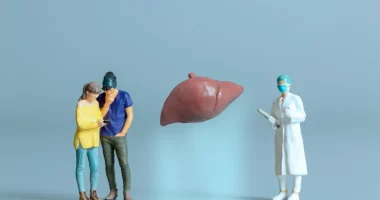Atherosclerosis is when arteries get narrow because plaque builds up on the walls. Arteries are like tubes that transport blood from the heart to the remaining parts of the body. They’re supposed to be smooth inside to let blood flow easily. This smoothness comes from a thin layer of cells called the endothelium.
When things like smoking, hypertension, or having too much fat, sugar, or cholesterol in the blood mess up this smooth layer, it’s called endothelial damage. This damage lets plaque, which is a mix of cholesterol and fat, to start to pile up inside the artery walls.
As time goes on, this plaque can get hard and make the artery even narrower. If too much plaque builds up, it can block the artery and stop blood from flowing normally.
Sometimes, bits of plaque can break off. When that happens, little parts of the blood called platelets rush in and stick together around the broken bits. This can form a clot that blocks the artery completely.
When an artery gets blocked like this, it can cause really serious problems like a heart attack or stroke. Atherosclerosis can happen in any artery, but it usually affects the big ones that have a lot of pressure.
Symptoms of Atherosclerosis
Atherosclerosis typically affects older individuals, though it can begin developing in adolescence. Initially, it may not show any symptoms until a piece of plaque ruptures or blood flow is significantly restricted, which can take many years.
Carotid arteries
Symptoms vary depending on which arteries are affected. Carotid arteries, which supply blood to the brain, can cause a stroke if blood supply is restricted. Signs of a stroke difficulty breathing, weakness, headache, paralysis, and facial numbness, require immediate medical attention.
Coronary arteries
Coronary arteries, which supply blood to the heart, can cause heart attacks and angina if blood supply is reduced. Symptoms may include vomiting, chest pain, coughing, extreme anxiety, and faintness.
Renal arteries
Renal arteries, which supply blood to the kidneys, can lead to chronic kidney disorder if blood supply is limited. Symptoms may include lack of hungry feeling, swelling of the feet and hands, and Concentration difficulties.
Peripheral arteries
Peripheral arteries, which supply blood to the limbs, can cause pain and numbness. In severe cases, gangrene and tissue death can occur. Peripheral artery disease also increases the chance of heart attack or stroke.
Treatment
Atherosclerosis, a potentially life-threatening condition, can be effectively treated, especially when addressed early to reduce the chance of serious complications.
Treatment targets to slow or prevent the growth of plaque, blood clots, and manage symptoms. Options include medications, lifestyle changes, and surgery.
Medication
Medications are tailored to individual needs and health conditions. Statins can handle cholesterol levels, while other drugs can reduce blood pressure, blood sugar, and prevent inflammation and clots. It’s important to follow a doctor’s instructions regarding medications and maintain a healthy lifestyle.
Lifestyle changes
Lifestyle changes such as avoiding smoking, moderate alcohol consumption, regular exercise, a healthy diet, and maintaining a healthy weight can significantly reduce the risk. Starting these habits early in adulthood can prevent problems later in life.
Surgery
In some cases, surgery may be necessary to ensure proper blood flow. Options include utilizing a stent to widen a blood vessel, bypass surgery to redirect blood flow, or surgery to eliminate plaque buildup, such as in the neck. These surgical interventions are typically reserved for severe cases of atherosclerosis.
Complications
Atherosclerosis can lead to various complications, including heart attack, heart disease, or heart failure, which can severely impact cardiac function. Peripheral artery disease may result, in affecting blood circulation to the limbs. Kidney failure is another potential complication as reduced blood supply can impair kidney function. Aneurysms, characterized by weakened artery walls, pose a risk of rupture. Stroke is a serious consequence when atherosclerosis affects arteries supplying blood to the brain.
Additionally, irregular heart palpitations and rhythms may occur, along with the risk of embolism, where a clot fragment detaches and travels through the bloodstream, potentially causing blockages in other areas. These complications underscore the importance of timely management and treatment of atherosclerosis to mitigate risks and preserve overall health.
Risk factors
Certain factors increase the risk of developing atherosclerosis, particularly for individuals with specific health conditions or lifestyle habits.
Those with insulin resistance or diabetes, a family history of cardiovascular disorder, or a part of tobacco smoking are at heightened risk. Additionally, high levels of LDL cholesterol, low physical activity levels, and advancing age contribute to increased susceptibility.
Unhealthy dietary patterns, such as consuming foods high in cholesterol, salt, saturated fat, trans fat, and sugar, also elevate the risk. Other risk factors include hypertension, obesity, elevated triglyceride levels, stress, excessive alcohol intake, and sleep apnea.
Recent research suggests that inflammation may also play a role in atherosclerosis development. Evidence indicates that exposure to air pollution could potentially increase the chance of triggering inflammation within the body. These risk factors underscore the importance of adopting healthy lifestyle choices and seeking appropriate medical management to mitigate the risk of atherosclerosis and related complications.
Outlook
Atherosclerosis is a severe condition that can be life-threatening. It can happen at any age, but it’s more common as people get older.
To lower the chance of atherosclerosis, it’s important to live a healthy lifestyle starting from a young age. For those who already have atherosclerosis, a doctor can suggest medications and lifestyle changes to reduce the chances of complications.
Summary
Atherosclerosis is a dangerous condition where arteries narrow due to plaque buildup, potentially leading to severe complications like heart disease, stroke, and kidney failure. Risk factors include diabetes, smoking, high cholesterol, and unhealthy lifestyle habits. Treatment options include lifestyle changes, medications, and surgery, aimed at slowing plaque development and managing symptoms.
Early adoption of healthy habits can reduce the risk of atherosclerosis. Medical guidance is essential for those with atherosclerosis to prevent complications and promote well-being. Understanding risk factors and adopting preventive measures are crucial for addressing atherosclerosis effectively.









